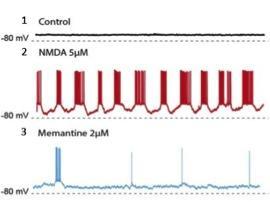Garcia-Munoz and Lopez-Huerta looked for the extrasynaptic receptors' purpose by first targeting slices of brain. The slices they used connected the striatum, part of the brain involved in movement, to the cortex, which they knew signals to the striatum. However, when they tried to provoke the striatum by stimulating the cortex, the striatal neurons were silent. Next, they added the neurotransmitter NMDA to the brain slice, where NMDA would interact with both synaptic and extrasynaptic receptors. This changed the sensitivity of the neuron by lifting the membrane potential, or the charge of the neuron. The higher the membrane potential, the less additional stimulation a neuron requires to fire an action potential. With the higher membrane potential in place, the researchers could trigger many action potentials. Finally, Garcia-Munoz and Lopez-Huerta added memantine, an Alzheimer's drug that slows the progression of dementia by blocking extrasynaptic receptors, and thus blocking the pathway that triggers cell death. With the memantine in effect and the extrasynaptic receptors out of commission, the researchers could only trigger a few action potentials using electricity. In this way, the researchers could tell that the extrasynaptic receptors were necessary to lift the membrane potential of the striatal cell, putting it in a more sensitive state.

The neurons in this video contain a dye that fluoresces when it encounters calcium ions. When the neuron is excited, calcium floods into the cell and the neuron fluoresces. The researchers monitored experiments such as this one to see which neurons were firing synchronously and which were firing separately.
(Photo Credit: Violeta Lopez-Huerta, OIST)
Next, Garcia-Munoz and Lopez-Huerta used calcium imaging to watch how extrasynaptic receptors changed the neural network. When a neurotransmitter interacts with a receptor, the cell opens gated channels. This allows positively charged calcium ions to enter through the cell's membrane, lifting the membrane potential. Garcia-Munoz and Lopez-Huerta added a dye to the system so that when calcium ions enter the cell, they interact with the dye, causing that cell to fluoresce. "Because the calcium is a direct measure of the electrical activity, you can see when the neuron is activated," Lopez-Huerta explained. "We can see the activity of hundreds of cells at the same time," she said. "Like fireflies," Garcia-Munoz added. Then, the researchers once again applied memantine to block the extrasynaptic receptors. The neurons fluoresced far less frequently and less synchronously.
Based on these experiments, Garcia-Munoz and Lopez-Huerta concluded that the extrasynaptic receptors were essential for establishing a plateau, a relatively long 200-millisecond lift in the membrane potential. Although plateaus do not cause action potentials, which last closer to one millisecond, the lift in electric charge gives the neuron a kind of leg up. In fact, Arbuthnott says that the plateau appears necessary for signaling. "The cells in the striatum don't fire action potentials unless they're up and in some kind of plateau state," said Arbuthnott. If this is the case for other parts of the brain, which the group thinks is possible, extrasynaptic receptors are essential for communication brain-wide. As Arbuthnott concluded, "If you need this plateau, you might need these extrasynaptic receptors."

Marianela Garcia-Munoz (left) and Violeta Lopez-Huerta (right) work in the Brain Mechanism for Behavior Unit, led by Professor Gordon Arbuthnott (center), where they recently completed a study on neurons receiving signals outside of their synapses.
(Photo Credit: Poncie Rutsch)

Extrasynaptic receptors are essential for producing activity in this striatal neuron. Neurons were recorded from brain tissue slices in three different conditions. In graph 1, the researchers electrically stimulated a neuron without any extrasynaptic response, or in a "down" state. In graph 2, the researchers added the neurotransmitter NMDA. This lifted the membrane potential, and made it possible to provoke many action potentials with electric stimulation. In graph 3, the researchers added memantine and showed that the drug blocks nearly all action potentials by blocking most extrasynaptic activity.
(Photo Credit: Ponce Rutsch)
Source: Okinawa Institute of Science and Technology (OIST) Graduate University